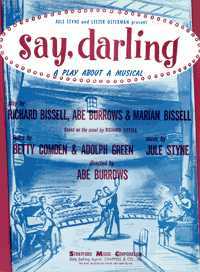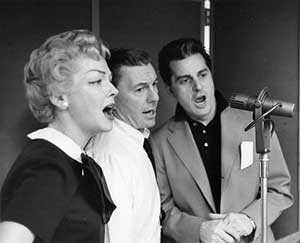Say, Darling
| Say, Darling | |
|---|---|
 Poster | |
| Music | Jule Styne |
| Lyrics |
Betty Comden Adolph Green |
| Book |
Abe Burrows Marian Bissell Richard Bissell |
| Basis | Richard Bissell's autobiographical book Say, Darling |
| Productions | 1958 Broadway |
Say, Darling is a three-act comic play by Abe Burrows and Marian and Richard Bissell about the creation of a Broadway musical. Although the play featured nine original songs with lyrics by Betty Comden and Adolph Green and music by Jule Styne, all of the songs were presented as either rehearsal or audition material and not as the thoughts or feelings of the characters.
Background
The original 1957 Broadway production featured only two pianos, but RCA Victor released a fully orchestrated original cast recording of the score, leading many to conclude that Say, Darling was actually a musical.
In a case of art imitating life not once, but twice, the show is an adaptation of Richard Bissell's semi-autobiographical novel of the same name which chronicled his experience adapting his novel 7½ Cents for The Pajama Game, making it in essence a play of a book about a musical adaptation of a book.
It focuses on Jack Jordan, who is brought to Broadway to help develop his best-seller into a musical for leading lady Irene Lovelle. His journey provides him - and the audience - with an education about what goes on behind-the scenes on the Great White Way, from auditions to rehearsals to rewrites in hotel rooms to feuds among cast members, all under the watchful eye of veteran stage producer/director Richard Hackett (loosely based on George Abbott) and a very young fledgling co-producer, Ted Snow, whose financial acumen greatly outweighs his show business savvy. Because of their similar physical appearance, actor Robert Morse (who played Snow) was widely thought to be imitating producer Harold Prince, who had co-produced The Pajama Game.
Productions

The Broadway production, directed by Burrows and choreographed by Matt Mattox, opened on April 3, 1958 at the ANTA Playhouse, transferring to the Martin Beck Theatre for the last five weeks of its 332-performance run. In addition to David Wayne as Jack Jordan, Vivian Blaine as Irene Lovelle, and Robert Morse as Ted Snow, the cast included Johnny Desmond (Rudy Lorraine), Jerome Cowan (Richard Hackett), Horace McMahon (Schatzie Harris), and Constance Ford (Frankie Jordan). Eddie Albert replaced Wayne later in the run. Appearing in small roles as chorus performers were Elliott Gould and Virginia Martin.
Morse was nominated for the Tony Award for Best Featured Actor in a Play and won the Theatre World Award for his performance.
The play was revived Off-Broadway at the West End Theatre in New York City for 16 performances in May through June 1996 under the direction of Robert Armin.[1][2]
An original cast recording was released by RCA Victor with orchestrations and musical direction by Sid Ramin. The 2008 CD release on DRG Records was re-edited from the first-generation master recording and interpolated five dialogue lead-ins that were not included on the 1958 LP release. The "long-lost" Robert Morse dialogue was not included.[3]
Songs
|
|
|
References
- ↑ blairstowntheaterfestival.com, biography of Robert Armin
- ↑ Willis, John."'Say Darling' listing, 1996, p. 158"Theatre World 1995-1996 Season, Hal Leonard Corporation, 1998, ISBN 1-55783-323-0 (books.google.com)
- ↑ amazon.com, Say, Darling - CD Reissue of 1958 Cast Album
External links
| ||||||||||||||||
| |||||